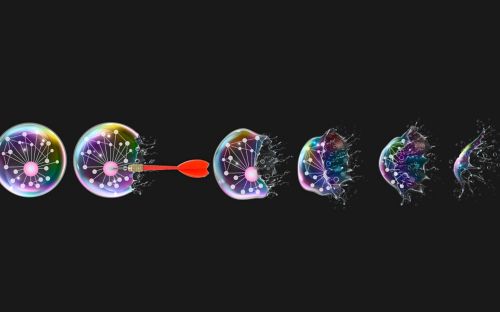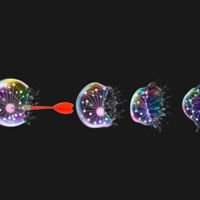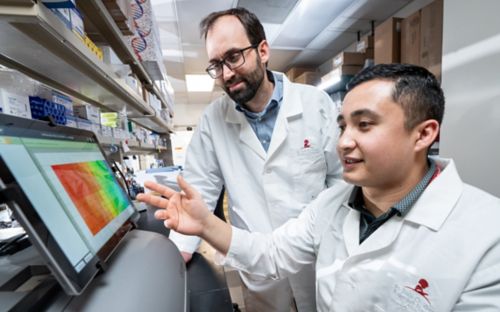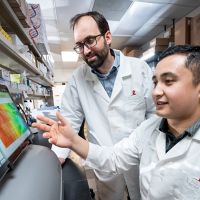Math helps biologist calculate variance of blood progenitor cells
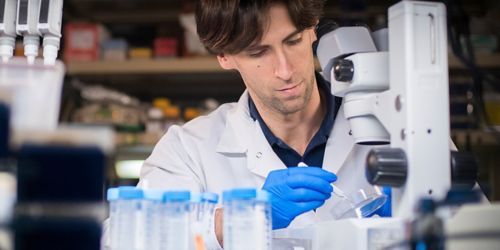
Miguel Ganuza, PhD, used math to solve a riddle about the origins of blood cells.
While scientific disciplines such as physics or chemistry have historically used it to form questions and find answers, math is a science that feels a bit mysterious to many researchers. Biologists routinely employ math to demonstrate statistical differences among experimental conditions or to plan sample sizes or randomize studies beforehand. But generally, math is not the first choice to address common biological questions
As I was finishing high school, I really loved math. I considered pursuing a career in it rather than biology.
Going Back to the Beginning to Understand Childhood Leukemia
Biology, not math, brought me to St. Jude Children’s Research Hospital as a postdoctoral fellow. When I began working in Shannon McKinney-Freeman’s lab, I became interested in understanding how hematopoietic stem cells (HSCs) emerge. These cells are responsible for life-long production of blood. HSCs arise from precursor cells that appear during embryonic development as little clusters mainly in the ventral wall of the aorta. Understanding how HSCs emerge can provide important insights into how childhood leukemias emerge.
These clusters of HSC progenitors are composed of cell types expressing different protein markers, defining different subgroups of cells within the cluster. To understand how these clusters emerge, I thought it would be interesting to analyze the expression profiles of cell cycle regulators within the different subgroups of cells.
Confetti System: A New Tool for Tracking Life-Long Blood Production
In discussing some early results with Per Holmfeldt, a former postdoc in the lab, he mentioned a tool called the Confetti system, which has been used in other tissues and may be useful to study these clusters. The Confetti system makes it possible to randomly and stably label cells and their progeny with one of four fluorescent proteins (green, yellow, red or cyan). If all the cells within a cluster were dividing from the same cell, all those cells will have the same color.
I realized this tool, in combination with mathematics, could be used in a more sophisticated way and allow us to decipher other long-standing complicated questions. The questions included the origin of the adult blood system early in development. This system can only label blood progenitor cells and their progeny with four colors, leading to adult blood labeled with up to four colors. This did not seem enough to track all the potential cell diversity of a complex system like blood.
One important point to remember was that the Confetti system randomly labels the cells with one of these four colors. For example, let’s say we have a bag full of marbles of four different colors: green, yellow, blue and red. If we let two persons to pick just one marble from that bag, it is very likely that the marble each of them picked will be different. In contrast, if we let each of them to pick 30 different marbles and then they compared among them the colors that they got, it is very likely that the distribution of the colors is more similar. As more marbles are picked, it will become more and more similar.
Applying this principle to our biological question, the more blood precursors (number of marbles picked) there are at a particular developmental time point, then the distribution of the confetti colors (green, blue, yellow, red) among different models (person picking marbles) will be more similar. In contrast, if the number of blood precursors were small, the random recombination of the Confetti allele would generate a distribution of Confetti colors that would be very different among mice, and thus the mouse-to-mouse variance in the distribution of Confetti colors would be higher.
The idea was that studying the variance in the distribution of Confetti colors in the peripheral blood among different adult mice would indicate the number of blood precursors that generated this distribution. To model this in vitro, I designed an experiment where known numbers of Confetti cells were plated in the laboratory, which allowed us to generate a formula that could correlate variance and number of precursors.
While the concept was clear, I did not have the expertise to capture the solution.
Math versus Dogma
Enter a mathematician. David Finkelstein, PhD, of Computational Biology, joined the team. He was paramount in generating and defining a formula that correlates both variables. We challenged his formula in a number of stringent functional tests and found it worked wonderfully for our purposes.
This formula allowed us to establish that embryonic blood origin is far more complex than previously assumed. Previous dogma considered that blood originated from a handful of precursor cells. Our results were published in Nature Cell Biology and showed that hundreds of embryonic blood progenitor cells early in development form the basis of life-long hematopoiesis.
Collaboration Helps Move Science Forward
The work demonstrated the importance of continuously discussing your results with your colleagues. Moreover, I realized how important it is to use varied expertise to answer long-standing questions. I have always loved mathematics, and other biologists would benefit from cultivating the same love.

